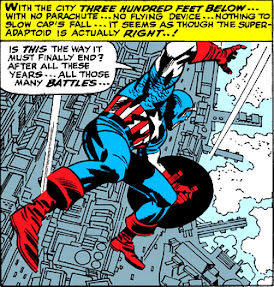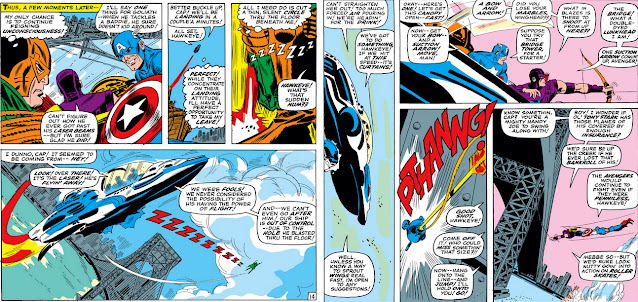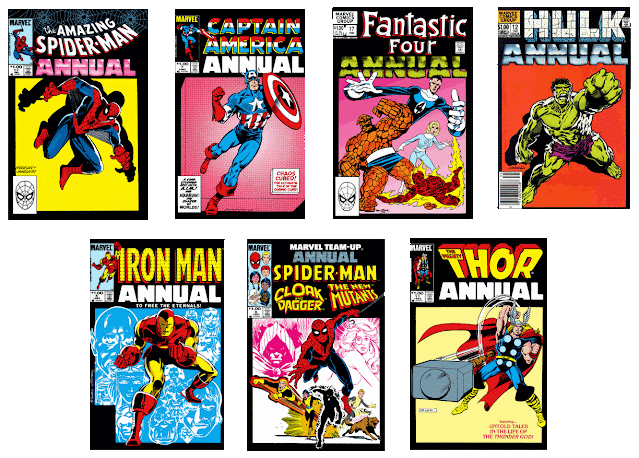Following a launch in early 1972 that saw its first four issues apparently competing with
Marvel's Greatest Comics as a reprint title for older Fantastic Four tales,
Marvel Triple Action then shifted its focus to offering reprints of
The Avengers--its covers for the most part mimicking MGC in retaining the original cover art of a story, interspersed with new covers drawn by contemporary artists of the '70s. Arguably, there may have been no
Avengers cover more in need of a makeover
* than that of the December 1966 issue, rendered by artist Don Heck and pictured here with Rich Buckler's interpretation of its events nine years later.
*Though I'd put the cover to issue #38 in the running.
As we can see, there are two schools of thought as to where the Avengers' fight with the Living Laser comes to a head. On the right, we see a deadly struggle taking place on a bridge in New York City--while on the left, our heroes are on the defensive with the Laser in the Central American country of Costa Verde (a locale which may sound familiar to you from another '70s story). Both covers retain the captions featured on the original--the title referring to Goliath sabotaging the Laser's powerful laser cannon, while Goliath's big change has him regaining his size-changing powers after becoming trapped at ten feet not long after rejoining the team.
While both covers have their peculiarities, it's the original which seems most in need of improvement. Even those behind the scenes in production seemed to recognize that, with what appears to be a last-minute substitution of the Captain America figure with one drawn by Jack Kirby, taken from an issue of Tales Of Suspense published in the same month:
As for the other figures, little thought has been given to what everyone is supposed to be doing (with the exception of the Laser's aggression). Even the Kirby figure's positioning is poorly chosen, having been dislodged (presumably by the Laser) from the cliff, with the Laser either opening fire on Cap's shield or Cap blocking the blast, both superfluous at this point. In the Laser's case, he's already sent Cap plummeting--why continue to fire at his target, much less at the wrong angle? And why should Cap worry about blocking a blast that would miss him?
And speaking of angles, who or what is Hawkeye aiming at? This marksman isn't going to hit the Laser at the angle he's positioned--maybe goons unseen off to the left? That leaves Goliath, who makes a great target for the Laser with his back turned to him; but at the moment, we can't be sure whether he's trying to save Cap, or if he's the one who threw Cap off the ledge in the first place.
On the MTA cover, Buckler's depiction is actually representative of the events taking place in the prior issue's story. But while the activities of the Laser and the Avengers are in the vicinity of the bridge, our motorists are only in the line of fire insofar as an attack by the Laser from miles away, and Buckler taking just a tad of artistic license with presenting a battle scene (and a bridge disaster) that never occurred.
Obviously Buckler is making better use of Cap's shield--but since we've already spent a good deal of time piling on and detracting from the merits of each of these covers, this may not be the time to mention the fact that Cap really has no shield to use at this point, given that his one-of-a-kind, indestructible shield was earlier destroyed by the Laser. (Buck up, Cap! Is that why you're jumping off a cliff?)























